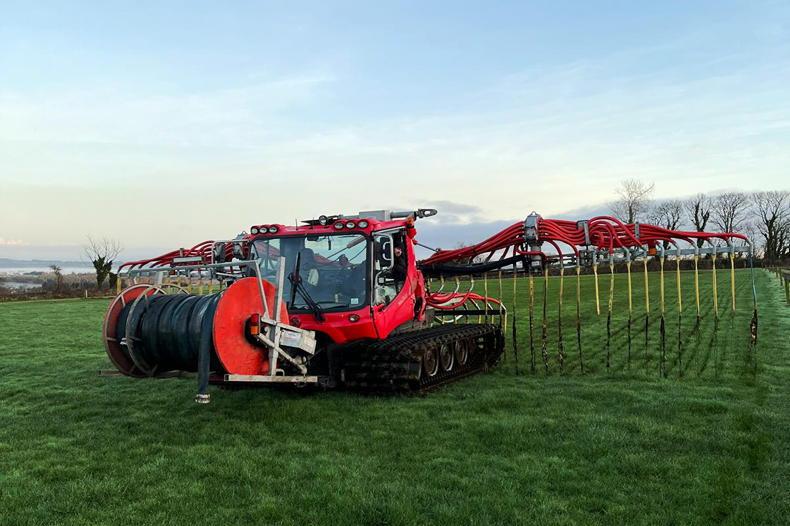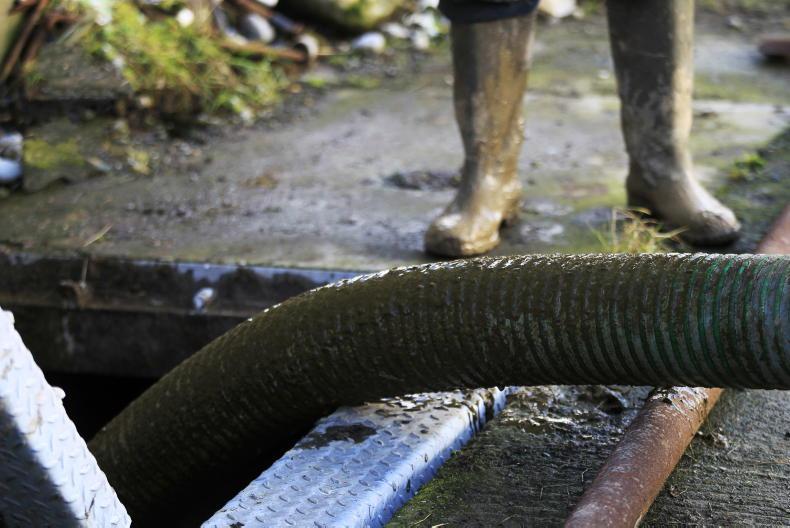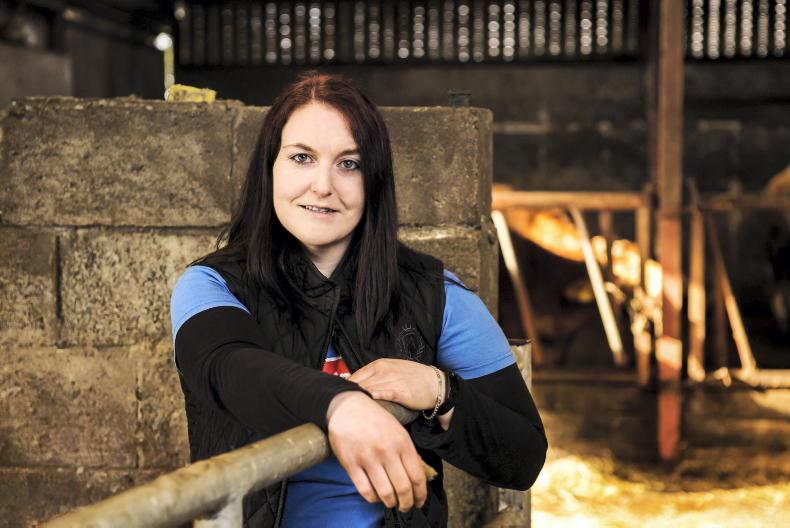Although ground conditions are currently saturated on the vast majority of livestock farms, over the next few weeks, the weather will hopefully improve and turnout to grass will be possible.
It has been a long winter and many farmers are physically and mentally drained at present.
Hopefully, once cattle start filtering out to grass, the change in the daily routine and an easing in the workload will lift the spirits, energizing farmers again.
Grazing in spring takes careful management, as weather conditions can quickly change and ground can be tender.
Regrowth on grazed paddocks can be slow and it is possible to run out of grass for a short period. When it comes to spring grazing, outlined are 10 tips to keep in mind.
1 Walk the farm first to assess conditions: not every field will be dry enough to carry cattle in late March or early April.
Equally, there will be fields that have good grass covers and some that are bare.
If there is a period of settled weather forecast, walk the grazing platform and get an idea of how many paddocks will carry cattle and how many animals to potentially graze.
The other thing is to plan out the first rotation as you walk, as wet or soft paddocks may need to be skipped.
That can complicate moving cattle between paddocks, but do not let it put you off.
Look to see what paddocks can be accessed by laneways, roadways or other hardcore areas, if needed.
Check boundary fences, water troughs and gates are all in working order before letting cattle out to grass.
2 Work out grazing days ahead: grass growth is likely to fall short of grazing demand up to late April. Therefore, the first rotation should be between 21 and 28 days to ensure cattle do not run out of grass.
To get a handle on grazing days ahead, work out the typical sward height in each paddock and how many hectares are available for grazing.
Available grass cover starts around 4cm in height.
If the sward is typically 8cm high, then there is 4cm available to cattle.
Every 1cm of available grass is roughly 200kg of dry matter per hectare. Assuming a 6ha grazing block (15 acres), averaging 6cm in height, that would give 2,400kg DM/ha of available grass.
Cattle will eat 2.5% of their body weight, so for a group of 10 stores weighing 400kg, that would give around 24 days of grazing.
3 Prioritise cattle for turnout and start small:
give priority to certain cattle groups for turnout. Lighter cattle will inflict less ground damage, eat less grass than cows and suit grazing in late March.
Maiden heifers that will calve at 24 months should be top priority for turnout and get preference over stores that will be grazed, housed and finished next spring.
In terms of spring-calving cows, target first calving heifers and older animals in poor body condition for turnout before the main run of cows.
When turning cows out, try to batch animals into breeding groups from the outset. That eliminates the need to change and regroup animals later in spring as the bulls go out.
Start off small and build numbers as ground conditions and grass covers permit.
Don’t get carried away by trying to empty the whole shed on one day.
4 Pre-turnout management jobs: before turning animals out to grass, check that dehorning and castration is up to date, as well as all routine vaccines under the herd health plan.
Cattle can lose ear tags over winter from rubbing on feed barriers, so make sure animals have two tags before turnout. Keep a note of animals in each grazing group.
5 Turning cattle out hungry: turning hungry cattle out to grass can help them settle faster. Ideally, cattle should go out to grass in late morning,as this gives them more time to settle before air temperatures start to drop in evening.
Turning cattle out in late afternoon can trigger pneumonia due to the sudden change in temperature from the shed to outdoors.
6 Hold off on setting up temporary electric fences: when cattle are turned out to grass, they will take off running as soon they enter the field. It will take a couple of hours for animals to settle and establish a social hierarchy.
During this time, cattle have a tendency to break through temporary electric fences, as they will be unfamiliar with them.
Therefore, allow cattle to settle first, then set up temporary fences in the evening or the next day to avoid wires being damaged.
7 Paddock size and protecting regrowth: be flexible with paddock sizes in early spring. Grazing groups will increase in size as ground conditions improve.
Slurry is high in potash (K) which inhibits magnesium uptake
The ideal paddock size in late March may be too small in late April.
Make use of reels, poly wires and battery fencers to provide grass in 48- to 72-hour allocations depending on land type.
Keep cattle moving to fresh grass to prevent poaching and encourage grass to regrow on grazed areas. If necessary, use a back fence on grazed areas.
8 Don’t force cattle to graze tight: if the first rotation is likely to be in late March or early April, and ground conditions are tender; do not force cattle to clean out every paddock tight to the ground.
In such scenarios, cattle will become increasingly unsettled as grass covers get low.
They are then more likely to poach ground or break through electric fences.
Paddocks can be cleaned out tight in the second rotation if conditions allow. Grass will not head out until June, so there is no issue with sward quality by leaving a higher residual in early April.
9 Preventing grass tetany: grass tetany is an issue with spring grazing. Lush grass and variable weather can trigger tetany, as can grazing swards too soon after a heavy slurry application.
Make sure cows with a calf at foot are properly covered for magnesium. If using lick buckets, offer one bucket per 10 cows and spread them across the field.
Cows with strong milking ability, suckling twins and first-calved heifers will be at most risk of tetany and should be carefully monitored.
Offering these animals a few flaps of hay in the days after turnout can also slow down digestion and reduce the risk of tetany.
10 Fertiliser: fertiliser will drive regrowth after the first rotation. Target 20 to 30 units/acre of nitrogen on grazed areas as soon as possible.
Slurry can be applied, but limit spreading rates to 1,500 gallons per acre and, if possible, use a trailing shoe to avoid sward contamination.
However, slurry is high in potash (K) which inhibits magnesium uptake. Therefore, allow at least three weeks before letting cows back into paddocks and keep on top of magnesium supplementation.
Read more
Date set for Teagasc's beef open day in Grange
Jump in Brazil’s beef export capacity to China
Although ground conditions are currently saturated on the vast majority of livestock farms, over the next few weeks, the weather will hopefully improve and turnout to grass will be possible.
It has been a long winter and many farmers are physically and mentally drained at present.
Hopefully, once cattle start filtering out to grass, the change in the daily routine and an easing in the workload will lift the spirits, energizing farmers again.
Grazing in spring takes careful management, as weather conditions can quickly change and ground can be tender.
Regrowth on grazed paddocks can be slow and it is possible to run out of grass for a short period. When it comes to spring grazing, outlined are 10 tips to keep in mind.
1 Walk the farm first to assess conditions: not every field will be dry enough to carry cattle in late March or early April.
Equally, there will be fields that have good grass covers and some that are bare.
If there is a period of settled weather forecast, walk the grazing platform and get an idea of how many paddocks will carry cattle and how many animals to potentially graze.
The other thing is to plan out the first rotation as you walk, as wet or soft paddocks may need to be skipped.
That can complicate moving cattle between paddocks, but do not let it put you off.
Look to see what paddocks can be accessed by laneways, roadways or other hardcore areas, if needed.
Check boundary fences, water troughs and gates are all in working order before letting cattle out to grass.
2 Work out grazing days ahead: grass growth is likely to fall short of grazing demand up to late April. Therefore, the first rotation should be between 21 and 28 days to ensure cattle do not run out of grass.
To get a handle on grazing days ahead, work out the typical sward height in each paddock and how many hectares are available for grazing.
Available grass cover starts around 4cm in height.
If the sward is typically 8cm high, then there is 4cm available to cattle.
Every 1cm of available grass is roughly 200kg of dry matter per hectare. Assuming a 6ha grazing block (15 acres), averaging 6cm in height, that would give 2,400kg DM/ha of available grass.
Cattle will eat 2.5% of their body weight, so for a group of 10 stores weighing 400kg, that would give around 24 days of grazing.
3 Prioritise cattle for turnout and start small:
give priority to certain cattle groups for turnout. Lighter cattle will inflict less ground damage, eat less grass than cows and suit grazing in late March.
Maiden heifers that will calve at 24 months should be top priority for turnout and get preference over stores that will be grazed, housed and finished next spring.
In terms of spring-calving cows, target first calving heifers and older animals in poor body condition for turnout before the main run of cows.
When turning cows out, try to batch animals into breeding groups from the outset. That eliminates the need to change and regroup animals later in spring as the bulls go out.
Start off small and build numbers as ground conditions and grass covers permit.
Don’t get carried away by trying to empty the whole shed on one day.
4 Pre-turnout management jobs: before turning animals out to grass, check that dehorning and castration is up to date, as well as all routine vaccines under the herd health plan.
Cattle can lose ear tags over winter from rubbing on feed barriers, so make sure animals have two tags before turnout. Keep a note of animals in each grazing group.
5 Turning cattle out hungry: turning hungry cattle out to grass can help them settle faster. Ideally, cattle should go out to grass in late morning,as this gives them more time to settle before air temperatures start to drop in evening.
Turning cattle out in late afternoon can trigger pneumonia due to the sudden change in temperature from the shed to outdoors.
6 Hold off on setting up temporary electric fences: when cattle are turned out to grass, they will take off running as soon they enter the field. It will take a couple of hours for animals to settle and establish a social hierarchy.
During this time, cattle have a tendency to break through temporary electric fences, as they will be unfamiliar with them.
Therefore, allow cattle to settle first, then set up temporary fences in the evening or the next day to avoid wires being damaged.
7 Paddock size and protecting regrowth: be flexible with paddock sizes in early spring. Grazing groups will increase in size as ground conditions improve.
Slurry is high in potash (K) which inhibits magnesium uptake
The ideal paddock size in late March may be too small in late April.
Make use of reels, poly wires and battery fencers to provide grass in 48- to 72-hour allocations depending on land type.
Keep cattle moving to fresh grass to prevent poaching and encourage grass to regrow on grazed areas. If necessary, use a back fence on grazed areas.
8 Don’t force cattle to graze tight: if the first rotation is likely to be in late March or early April, and ground conditions are tender; do not force cattle to clean out every paddock tight to the ground.
In such scenarios, cattle will become increasingly unsettled as grass covers get low.
They are then more likely to poach ground or break through electric fences.
Paddocks can be cleaned out tight in the second rotation if conditions allow. Grass will not head out until June, so there is no issue with sward quality by leaving a higher residual in early April.
9 Preventing grass tetany: grass tetany is an issue with spring grazing. Lush grass and variable weather can trigger tetany, as can grazing swards too soon after a heavy slurry application.
Make sure cows with a calf at foot are properly covered for magnesium. If using lick buckets, offer one bucket per 10 cows and spread them across the field.
Cows with strong milking ability, suckling twins and first-calved heifers will be at most risk of tetany and should be carefully monitored.
Offering these animals a few flaps of hay in the days after turnout can also slow down digestion and reduce the risk of tetany.
10 Fertiliser: fertiliser will drive regrowth after the first rotation. Target 20 to 30 units/acre of nitrogen on grazed areas as soon as possible.
Slurry can be applied, but limit spreading rates to 1,500 gallons per acre and, if possible, use a trailing shoe to avoid sward contamination.
However, slurry is high in potash (K) which inhibits magnesium uptake. Therefore, allow at least three weeks before letting cows back into paddocks and keep on top of magnesium supplementation.
Read more
Date set for Teagasc's beef open day in Grange
Jump in Brazil’s beef export capacity to China










SHARING OPTIONS